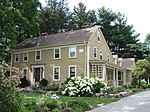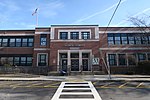Dr. Henry Jacob Bigelow House
Henry Hobson Richardson buildingsHouses completed in 1887Houses on the National Register of Historic Places in Newton, MassachusettsShingle Style architecture in MassachusettsShingle Style houses

The Dr. Henry Jacob Bigelow House is a historic house at 72-80 Ober Road in the Oak Hill village of Newton, Massachusetts. Built in 1887, it is one of the last private residences designed by noted American architect Henry Hobson Richardson. It was converted into condominiums in the 1980s by the PBS program This Old House. It was listed on the National Register of Historic Places in 1976.
Excerpt from the Wikipedia article Dr. Henry Jacob Bigelow House (License: CC BY-SA 3.0, Authors, Images).Dr. Henry Jacob Bigelow House
Ober Road, Newton Oak Hill
Geographical coordinates (GPS) Address Nearby Places Show on map
Geographical coordinates (GPS)
| Latitude | Longitude |
|---|---|
| N 42.3025 ° | E -71.186944444444 ° |
Address
Ober Road 72;74;76;78;80;82
02459 Newton, Oak Hill
Massachusetts, United States
Open on Google Maps







